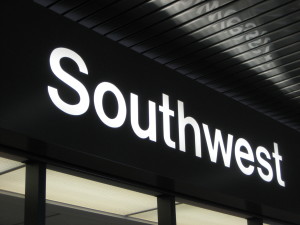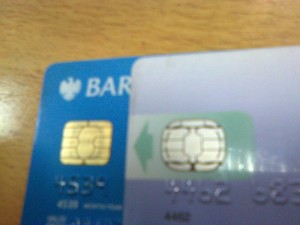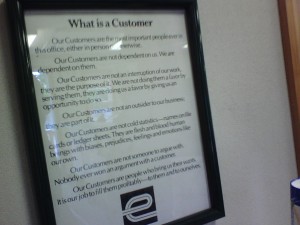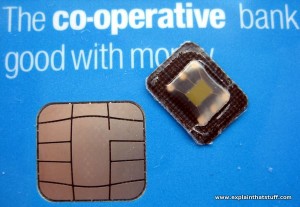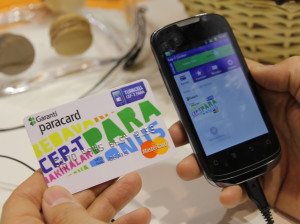May 30th, 2014 by Elma Jane
Southwest Airlines is now accepting mobile boarding passes at 28 total U.S. airport locations, its newest convenience feature that enables fliers to pass security and board an aircraft simply by waving their mobile device.
Following a tiered rollout from last year, the paperless boarding system requires minimal user action. Passengers check in via the Southwest mobile site or branded app and choose to view their boarding pass. The image will open in a new browser and can be saved to a device’s photo gallery upon request.
Mobile apps are critical touch points in the customer journey. Native and hybrid apps are continuing to dramatically increase the ability to deploy and optimize digital strategy. If you’re customizing the experience on mobile Web only, you’re missing a huge opportunity.
Long awaited arrival
New airline initiatives are offering a level of customer service that has never before been possible, and is transforming the experience of traveling to create a new barometer on which carriers will be judged.
Southwest offers two ways to attain an e-boarding pass: have one sent directly to a mobile device though electronic mail or text message when checking in online, or use the airline’s app to check in and have the pass appear with the option to save a replica to the photo gallery. When ready for boarding, passengers present their screen at both security checkpoints and gate entrance to be scanned by staff. In addition to mobile boarding pass support, the app also now includes upcoming trip cards that display flight information such as boarding position, gate location and access to flight tools such mobile check-in from the home screen.
IT takes flight
An industry wide Airline IT Trends Survey shows that more than 90 percent of airlines are increasing their investment in mobile capabilities to ease the hassles of getting through the airport and improve the in-flight experience. American, Delta, Continental and United are the biggest adopters of e-boarding support, offering the service from at least 75 airports. Mobile boarding passes are the preferred method for frequent fliers, as business execs and the like are constantly engaged with their handhelds. Paper passes also become more likely to be lost or wrinkled.
Another advantage of the electronic offering is that some travelers may not have access to a printer, and so a mobile boarding pass relieves the frustration of waiting on line at a kiosk. Of course there are also obvious drawbacks that may hinder the proposed convenience factor, one being that a mobile device may malfunction or run out of battery, resulting in a delayed trip or even a missed flight.
Mobile passes may also present a challenge if multiple people are traveling under one reservation. U.S. Airways and Continental restrict the service to one person per reservation. Other airliners allow each group member to check in line and have a separate pass sent to appropriate phones. While certain cons defeat the purpose of going mobile for efficiency reasons, the benefits offer peace of mind as airline carriers continue to improve the technology.
The option helps deliver more personalized and relevant experiences to on-the-go consumers leveraging a unified customer profile to collect, own and act on data not only on mobile apps, but also across kiosks and other platforms. This approach to mobile apps uniquely sets marketers free in terms of customization and delivery of the experience, and has delivered great results.
Posted in Smartphone Tagged with: airline carriers, airports, American, app, boarding pass, cards, carriers, consumers, Continental, customer service, data, Delta, digital, e-boarding pass, electronic mail, hybrid apps, mobile, Mobile Apps, mobile boarding, mobile device, Mobile passes, mobile site, mobile Web, phones, platforms, Security, technology, tools, U.S. Airways and Continental
May 23rd, 2014 by Elma Jane
State senate in California is advancing a bill SB 1351, mandates April 1, 2016, that would require California-based bankcard issuers and retailers to adopt Europay/MasterCard/Visa (EMV) chip card technology. SB 1351 bill is introduced March of 2014, passed out of committee on May 6 and may be voted on by the full senate as early as tomorrow, May 22nd.
Additionally, the bill specifies that any contracts entered into by financial institutions and card brands on or after Jan. 1, 2015, would have to include the provision that any new or replacement cards issued after April 1, 2016, be EMV compliant. The rationale for the bill comes from oft-cited evidence that EMV cards substantially reduce fraud.
In April 2014, Sen. Hill stated, My legislation holds all stakeholders accountable to protect consumers from scam artists who use fake cards to game the system.
The Electronic Transactions Association, however, does not see the issue the same way. Passing a single state technology standard will open the floodgate to additional state responses and create an expensive, unsafe and inefficient myriad of technology standards, the ETA said. The ETA is urging payment professionals in California to contact their legislators and let their opinions be heard.
The bill initially mandated Oct. 1, 2015, as the deadline for EMV implementation, which is the date set by Visa Inc. and MasterCard Worldwide for retailers to be EMV complaint or face potential fines in case of fraud. The bill also makes exceptions for small retailers and convenience stores/gas stations; they have until Oct. 1, 2017, to transition to EMV.
Posted in Best Practices for Merchants, Credit card Processing, EMV EuroPay MasterCard Visa Tagged with: bankcard, card brands, card technology, cards, chip, consumers, Electronic Transactions Association, EMV, EMV compliant, EMV implementation, ETA, Europay/MasterCard/Visa, fake cards, financial institutions, fraud, MasterCard, payment professionals, retailers, scam, small retailers, technology standards, Visa Inc.
May 16th, 2014 by Elma Jane
As much as you’d like to hope that no one will ever be unhappy with your product or service, you’re almost guaranteed to encounter at least a few customers who are less than fully satisfied. Where there are customers, there are complaints.
As consumers increasingly air their grievances about brands on social media, the focus has turned to the way those brands respond to customer complaints, especially in a public forum. Knowing what to do in this situation makes all the difference when it comes to re-earning a customer’s business and what he or she tells others about your company.
Great service is about getting your customers to trust you and count on a consistent experience, but that doesn’t mean you’re always going to be perfect. In a crisis, you can elevate your stature with how well you handle the situation. A negative experience can be the best time to show your value.
Great service has to come from the top. Lower level employees aren’t going to be inspired and motivated unless they see their leader providing exceptional service.
No matter which person on your team is responsible for handling customer relations, it’s imperative that you embody excellent service as the head of the company as well.
If faced with negative customer experience follow these steps to resolve the issue and regain customer’s trust.
Acknowledging the problem – Customer is always right classic customer service cliché. While it may in fact, turn out to be a misunderstanding, the worst thing you can do is dismiss a customer who tells you he or she had a problem with your business.
Apologizing for it – Once you’ve acknowledged the customer’s issue, apologize for it and ask what you can do to help. Gather the facts about the situation and determine a course of action from there.
Taking action – Saying you’re going to fix a problem is one thing, actually doing it is another. Make sure you honor your commitment to take care of the customer’s complaint. If you can’t correct the problem, offer a coupon or voucher as a way to ask the customer for another chance.
Follow up – When you’ve done what you promised to do, follow up with the customer to make sure that your solution was satisfactory.
Posted in Best Practices for Merchants, nationaltransaction.com Tagged with: brands, consumers, coupon, customer relations, customers, forum, product, public forum, service, social media, value, voucher
May 9th, 2014 by Elma Jane
Facebook is apparently ready to become a person-to-person (P2P) money transfer network. The clear decision to launch a money transfer service in the region can be seen as a test bed for Facebook’s larger ambitions of becoming a payments hub for its 1 billion user base. Facebook was only weeks away from gaining regulatory approval in Ireland for its remittance platform FT quoted unnamed sources. Facebook’s P2P platform will be geared to facilitating migrant remittances, with the goal of expanding its payment presence in emerging markets such as India. Facebook makes the bulk of its revenue from advertising, but 10 percent of its profits reportedly come from in-game payments for online and mobile games, such as Zynga’s popular FarmVille.
From WhatsApp to what’s next
Facebook’s February 2014 acquisition of mobile messaging service WhatsApp for $19 billion clarified the social network’s strategy. The WhatsApp acquisition and the expected P2P network launch as part of the first phase of Facebook’s deeper immersion into payments.
Tech giants face up to payments
When comparing the payment strategies of tech giants Google Inc., Apple Inc. and Facebook, the latter two competitors as having bigger potential upsides than Google. Facebook and Apple (via iTunes) already have established financial relationships with millions of users who have attached funding mechanisms – debit and credit cards – to their social media accounts. As primarily a search engine, Google is playing catch up to persuade its users to set up Google Wallet accounts.
In May 2013, Google launched its own P2P network by integrating Google Wallet with Gmail accounts, so that wallet users can facilitate money transfers via email. More recently, reports have surfaced indicating Google plans to extend Google Wallet to its wearable technology solution Google Glass. But the success of such ventures rests on users’ confidence with Google as a financial service provider.
Facebook as having a brighter financial services future than Apple. Apple’s reach is limited to consumers who have iPhones and iPads, whereas Facebook is not tied to any branded mobile devices, it is a very ubiquitous offering. It could apply to anybody with any type of phone or tablet.
Eventually, tech companies like Facebook will need to partner with payment businesses in order to expand into the merchant-centric brick-and-mortar world. The mobile POS solution provider, a business unit of global POS terminal manufacturer Ingenico SA, would be an ideal partner for Facebook. If they extend what they do from P2P payments to more of a wallet purchasing capability for their users, then the next step could very easily be an extension of that into servicing the merchant side.
Posted in Financial Services, Mobile Payments, Smartphone Tagged with: Apple Inc.Facebook, consumers, credit cards, debit, device, financial service, financial service provider, Gmail accounts, Google Glass, Google Inc., Google Wallet accounts, ingenico, iPads, iPhones, iTunes, merchant-centric brick-and-mortar, migrant remittances, mobile, Mobile Devices, mobile games, mobile messaging service, mobile pos, mobile POS solution, mobile POS solution provider, money transfer, money transfer network, money transfer service, network, online, p2p, P2P network, P2P payments, P2P platform, payment businesses, payments, payments hub, phone, POS terminal, remittance, remittance platform, search engine, service provider, social media, social media accounts, social networks, tablet, wearable technology
May 6th, 2014 by Elma Jane
MasterPass in-app payments is this latest offering from MasterCard to address the specific needs of the digital ecosystem. With MasterPass in-app payments, MasterCard is creating great experiences for consumers across all channels and all devices, and enabling merchants to reach new consumers in ways not possible in the pre-digital world.
MasterPass an in-app payments enabling consumers to make secure purchases within a mobile app has been announced by Mastercard. MasterPass in-app payments eliminate the need to store payment card credentials across numerous mobile apps, providing consumers with a fast and simple payment experience.
MasterCard is also developing a framework to make all payments using MasterPass as or more secure than anything, ensuring that consumers can benefit from the highest possible levels of security.
MasterPass in-app payments extend the capabilities of the current browser-based MasterPass digital service into the mobile app environment, and provide consumers with one secure direct relationship with their bank. Apps with MasterPass embedded in them enable consumers to complete a purchase with as few as one click or touch on their favorite connected device without leaving the app environment. MasterPass in-app payments will be made available to developers and merchants beginning in Q2 of this year.
Posted in Best Practices for Merchants, Digital Wallet Privacy, EMV EuroPay MasterCard Visa, Financial Services, Mobile Payments, Payment Card Industry PCI Security, Smartphone, Visa MasterCard American Express Tagged with: card credentials, consumers, digital service, in-app payments, MasterCard, MasterPass in-app payments, Merchant's, mobile app, payments, pre-digital, Security
April 11th, 2014 by Elma Jane
Of the 17 percent of consumers who reported having had their credit card declined during a card-not-present (CNP) transactions. As many as one-third of those declines were unnecessary. The result is consumer aggravation, increased operational costs for banks and credit card companies and as much as $40 billion in lost revenue for online retailers.
TrustInsight which helps establish trusted relationships between financial institutions, merchants and online consumers conducted study. A report and infographic detailing the findings of the study found that avoidable online credit card declines lead to loss of trust for consumers, sales for merchants and increased operational costs for credit card companies and issuing banks.
Study also revealed that consumers handle credit card declines in a variety of ways all of which carried negative economic impact to at least one party in the transaction, resulting in unnecessary operating costs for banks, decreased loyalty for the credit card company and lost revenue for all. Almost half call their issuer immediately when their card is unexpectedly declined. This is a natural response. 34 percent of consumers try again another credit card, other use a different payment method and 24 percent will skip the purchase altogether or shop at a different online retailer.
No one wants to turn away business, and no one wants their business declined. The frustration and impact of wrongful declines is a real problem especially as more and more transactions occur in non-face-to-face situations.
Impact of consumer action in the face of a decline can have real and measurable effects on all parties, including credit card companies, banks and merchants manifesting itself in lost customer loyalty, lost fees and lost revenues. Creating a standard for online trust that enables credit card companies, merchants and issuing banks to better recognize trusted digital consumers and reduce the number of wrongly declined consumers avoiding unnecessary losses.
In a world where people are increasingly reliant on a variety of Internet-connected devices for everything from banking to shopping to entertainment and media, creating friction-free customer experiences and preventing online fraud are constant business challenges.
Posted in Best Practices for Merchants, Credit card Processing, Credit Card Security, Electronic Payments, Financial Services, Gift & Loyalty Card Processing, Merchant Services Account, Small Business Improvement, Visa MasterCard American Express Tagged with: banking, consumers, credit-card, decline, declined, declines, different payment method, digital, digital consumers, financial, frustrate, internet-connected devices, issuing banks, loyalty, Merchant's, online credit card declines, online fraud, online retailers, shopping, transactions, wrongful declines, wrongly declined
December 19th, 2013 by Elma Jane
10 Great Ecommerce & Mcommerce Ideas
Address Commonly-asked Questions
Instead of hiding commonly asked questions on an FAQ page somewhere on your site, display these answers in plain sight. Include your service agreement on every page, and provide frequent updates on orders in the mail, because one of the quickest ways to lose shoppers and sales is to make it difficult for them to do business with you.
Connect with Pinterest Influencers
Connect with the Pinterest influencers…accounts or boards with large followings…that relate to your product category. Ask for a pin here and there for a product you believe they would like. You’ll get large amounts of traffic, sales, and repins from their large followings. This method is repeatable and much quicker and cheaper than building a large following yourself.
Don’t Forget Comparison Shopping Engines
You’ve got a great ecommerce website. But is it hard to get traffic? Comparison shopping engines (CSEs)…like Google Shopping, Shopzilla, NexTag, Pronto, and Bing…deliver millions of shoppers to product pages every day. You list your items on the CSEs where purchase-ready shoppers will see them and click through to your site to complete the transaction. CSEs typically have a pay-per-click pricing model, and many merchants find it’s worth the cost.
Emphasize Product Photography
Whether you use high-quality renderings or actual product photography, make sure you take the time to present your products in the best possible manner. With the proliferation of product and photo sharing sites like Pinterest, The Fancy, Instagram, and OpenSky, having a beautiful product shot is imperative. Lifestyle shots of your product in use could also significantly increase conversion rates.
Make Research Easy for Prospective Buyers
Research (for buying decisions) is a massive resource cost to businesses around the world. It is also a primary reason for lost deals. Were you to provide comprehensive information that was easy to find and on which a buying decision can be made, then your close rate would substantially improve. Add to this, an easy purchasing process and, rather than scouring the web, a buyer would see your site as a preferred source.
Mimic the Brick-and-mortar Experience
Regardless of what channel they may be using to shop, online consumers are demanding the quality of the brick-and-mortar experience. They want to zoom in on a product, rotate it, change its colors…in short, they want to interact with the item as though they were physically in the same room with it. Retailers with rich interactive media that can offer this in omnichannel have a significant competitive advantage during the holiday season and can convert at rates of 30 percent higher than those that don’t.
Offer Support via Social Media
Nielson research discovered that in 2012 one-third of social media users prefer to contact a company via social media than by phone. On your support pages, provide links to your social media profiles. Set up notifications in the social media accounts so you know when someone contacts you. This way you provide timely customer support to those who want it…in the way they want it.
Stay Ahead of the Curve
“It doesn’t take a lot of time for cutting-edge to become old hat. Keep researching to be aware of the latest tools and technology. If you stay still, you will find that your competitors will quickly surpass you.
Take the ‘E’ out of ‘Ecommerce’
Retailers need to realize that the lines of commerce have been, as John Donahoe, CEO of eBay, said, obliterated. It’s no longer a world of online and offline commerce. It’s just commerce. Retailers are competing on a global scale with everyone, everywhere. You need to give shoppers a compelling reason to buy from you. Find a way to differentiate and make sure you can grab shoppers attention and keep them coming back.
Think Like a Shopper
Keep your site’s design simple and clean, make calls-to-action clear, and focus on the product. Go through the flows of your site: search, browse, and buy a product, or have a friend do it and watch him without helping. Pay attention to areas where anything is confusing, doesn’t work the way it should, or takes too many steps. Then make adjustments.
Posted in Credit card Processing, e-commerce & m-commerce, Electronic Payments, Internet Payment Gateway, Mobile Payments Tagged with: brick and mortar, buying, channel, consumers, conversion, convert, customer support, e-commerce, ecommerce, interactive, m-commerce, mcommerce, media, omnichannel, online, orders, photo, product, profile, purchasing, retailers, sales, shopping, site, social media, transaction
November 14th, 2013 by Elma Jane
Los Angeles-based company Verifi, providing antifraud and risk-management services recently secured a patent for its dispute-resolution technology that enables merchants to avoid chargebacks by turning them into refunds earlier in the process. According to the patent abstract, the patent covers “receiving, at the partner platform, an inquiry/dispute event notification,” and “refunding the transaction or canceling future or recurring charges associated with the transaction.”
Verifi noted in the patent application, consumers are increasingly contacting their issuing bank first in the case of a disputed credit or debit card charge, cutting the merchant out until later in the process. The patent in question, in addition to streamlining the process for issuers engaged in the dispute process, helps recurring merchants by removing cardholders from the recurring payment program during the resolution process so additional charges will not come into question until the original dispute is settled.
Posted in Best Practices for Merchants, Credit card Processing, Payment Card Industry PCI Security Tagged with: antifraud, cardholders, chargeback, consumers, dispute-resolution, disputed, inquiry/dispute, issuing, Merchant's, patent, payment, platform, process, receiving, recurring charges, refund, refunding, resulution, risk-management, Security, services, settled, transaction, verifi
November 14th, 2013 by Elma Jane
Micropayments provide faster results and some immediate gratification that can keep you motivated. Rather than eating out or splurging on something that you don’t really need, immediately apply that money to pay down your credit card balance. Instead of paying a certain amount once a month, divide that payment in half and pay that amount every two weeks. Consumers can even sign up for an electronic transfer of your funds to take place every two weeks. By the end of the year, you will have made 26 payments or the equivalent of 13 monthly payments. The extra monthly payment resulting from this payment plan will enable you to pay down your debt at a faster pace.
If you are planning to make micropayments, consumers may want to call their credit card company to verify that separate payments can be made and will be credited to their monthly minimum. See if your issuer has any restrictions or limitations on making additional payments.
Holiday shopping is just around the corner, and consumers need to have their credit card balances as low as possible in order to avoid costly interest charges. One way to do this is to make micropayments on their credit card bill. While we are conditioned to pay our credit card bill once a month, consumers can actually make a number of smaller payments throughout the month. Some banks and issuers allow payments to be made as often as once a day. If you carry a balance, micropayments can reduce the interest because most credit card companies charge interest based on your average daily balance during the month. Pay more often and you reduce your average daily balance and therefore the interest you pay that month.
If you have more than one card with a balance, keep paying the minimums for each card, but pick one card to pay off first. Select either the card with the highest interest rate (save more money) or the card with the lowest balance (pay it off faster). Stop charging on that card, using another card for purchases.
There are several other advantages to making micropayments when paying down credit card debt:
You may have better control of your payments. If you are paid weekly or bi-weekly, money can slip away by the end of the month. Designate a specific day after you are paid to send in a payment for your credit card. Four $50 payments or two $100 payments are sometimes easier to make than a monthly $200 payment. It is also easier to add a little extra money to smaller payments.
In time, micropayments can help raise your credit score. An organized, scheduled payment plan can help you avoid late payments and pay more than the minimum due. Both of these are important elements for a good credit score.
Micropayments can reduce financial stress. Making payments right after payday at a time when you actually have the money will likely reduce anxiety and financial stress.
The higher your interest rate, the more you will save.
The disadvantage to the micropayment plan is that it takes time, organization and financial discipline to make the plan work and this may be difficult for some people.
Posted in Electronic Payments, Financial Services, Visa MasterCard American Express Tagged with: balance, bill, consumers, credit-card, credited, debt, elements, financial, interest, issuers, limitations, micropayments, money, monthly minimum, pay, payments, purchases, shopping
October 24th, 2013 by Elma Jane
Reflecting recent research that concludes mobile payment adoption remains low, Total System Services Inc. (TSYS) issued results from a survey that confirm consumers prefer banking applications other than payments for their mobile devices.
While reinforcing the dominance of debit and credit cards as payment mechanisms, the TSYS 2013 Consumer Payment Choice Study revealed that mobile devices are used as a tool for ancillary financial services, such as checking account balances and accessing discounts and rewards.
“For now, the hype largely remains hope for mobile from a payments standpoint,” the survey said. “On a relative basis, consumers would overwhelmingly prefer to have the ability to use their smartphone to monitor transaction activity or prevent fraud versus using their mobile phone as a form factor in a transaction.”
Columbus, Georgia-based processor TSYS found in its third annual survey that, out of 1,000 consumers surveyed online in the summer of 2013, 40 percent of respondents were interested in using mobile devices to instantly stop illegitimate transactions. Additionally, 37 percent indicated that the ability to view in real-time the transactions made with debit and credit cards was also an important feature.
Receiving instant offers and promotions from stores being visited (33 percent); temporarily blocking and unblocking purchases using certain bankcards (29 percent); and paying for purchases using reward/loyalty points (28 percent) rounded out the top payment-related uses for smartphones.
At the bottom of the scale was to pay for purchases with mobile wallets (25 percent) and to use credit or debit card-funded prepaid accounts for the same purpose (22 percent). “Industry observers regard mobile payments as an assumed eventuality,” TSYS stated. “Our survey results indicate that consumers are presently more interested in increased non-payment functionality on their mobile device.”
But the processor remains optimistic about the promise of mobile payments. “We believe that as the infrastructure matures and the ability to use mobile payments becomes more widespread, this trend will change,” TSYS said.
Prepaid undermarketed?
In addressing the role of prepaid cards in the payment mix, TSYS expressed surprise that prepaid cards are apparently not being marketed aggressively by financial institutions. The processor noted that major banks jumped into the prepaid card industry in 2012 to offer general-purpose reloadable (GPR) prepaid cards as checking account alternatives.
But TSYS found that just over 10 percent of survey respondents indicated they had received GPR card offers from their banks. TSYS attributed that low percentage to the fact that the survey respondents were by default credit and debit card users, while GPR cards are primarily targeted to individuals without access to credit or debit cards.
Regardless, survey respondents aged 35 and younger accounted for 64 percent of those who had received such offers. “It could be that the younger demographic on average represents a less profitable checking relationship for banks, or that banks perceive them to be more receptive to the offering,” TSYS said.
Steady goes debit and credit
Consumer payment preferences in 2013 remain relatively unchanged from previous years, according to TSYS. Debit still trumps credit as the preferred payment instrument overall, with both methods being favored by every eight of 10 survey respondents. Debit is still the clear winner when it comes to supermarket shopping and gas purchasing, while credit is preferred when dining out and shopping in department stores. But when it comes to fast food cravings, cash is still king.
On the opposite end of the spectrum, and also consistent with TSYS’ 2012 report, only 11 percent of respondents said being able to set up text message alerts for account balances and transactions was most valuable, and a mere 6 percent valued the ability to register payment cards in mobile wallets.
However, credit tops debit for online purchases, TSYS said. Further of note is that PayPal Inc.’s digital wallet service rivals debit online, with both payment methods favored by roughly one-fifth of respondents. But for small-dollar purchases, like coffee and donuts, cash remains the preferred payment vehicle, despite innovative mobile schemes offered by companies like Starbucks and Dunkin’ Donuts.
Posted in Credit card Processing, Digital Wallet Privacy, e-commerce & m-commerce, Electronic Payments, Gift & Loyalty Card Processing, Internet Payment Gateway, Mail Order Telephone Order, Merchant Services Account, Mobile Payments, Smartphone Tagged with: account, adoption, applications, banking, checking, consumers, credit cards, debit, devices, discounts, financial services, form factor, general-purpose, gpr, infrastructure, low percentage, mechanisms, mobile, mobile wallets, non-payment, offers, online, payment, payment related, phone, prepaid, processor, profitable, promotions, real-time, reloadable, reward/loyalty, rewards, smartphone, transaction, tsys
